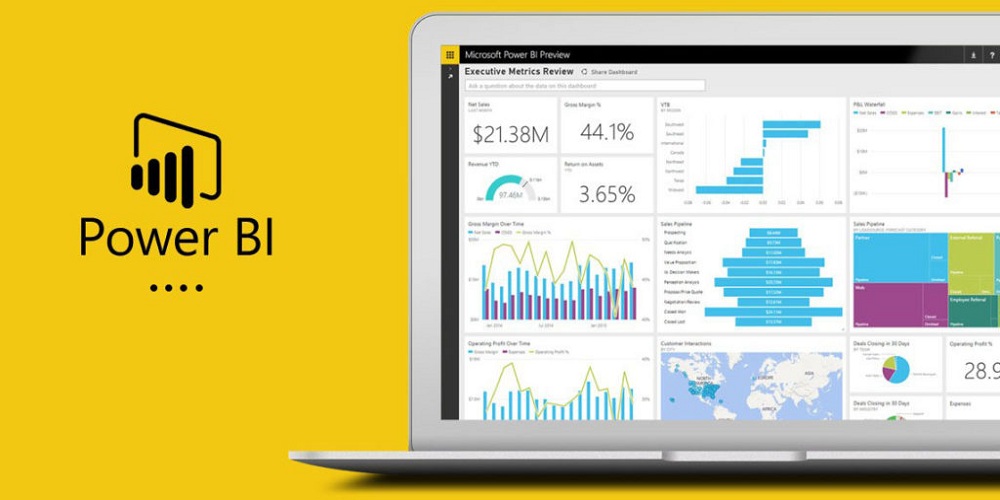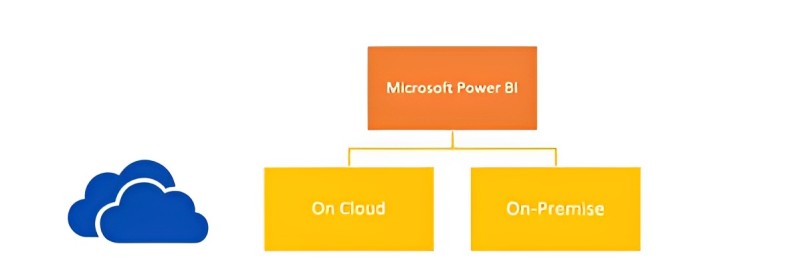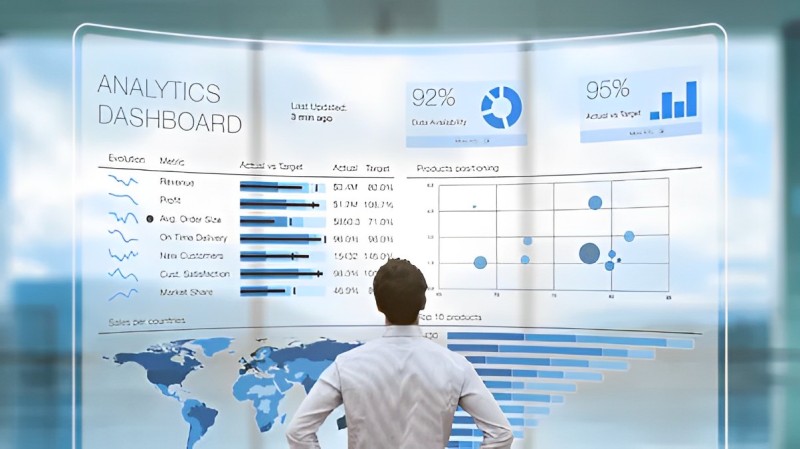
Power BI is a suite of Smartphone platforms developed by Microsoft for use on several mobile devices. The Power BI Report Server, for example, is a web interface that is physically located on the premise and that you can use to handle reports and key performance indicators (KPIs).
Various technologies are necessary to build horizontally scrolling reports, touch screen reports, and key performance indicators (KPIs). Thus, how can Power BI reporting and Power BI consulting help a company grow? First, it gives the ability to generate intelligent reports with the aid of contemporary business intelligence reporting technologies and construct a complete intelligent reporting practice. Consequently, Power BI development services may assist a company's general development and its profit, irrespective of its specialization or any sector.
What exactly is Power BI Reporting?
Business intelligence reporting, often known as BI reporting, is the process of obtaining data and extracting meaningful insights from it via various technologies and tools. In the end, it offers ideas and remarks regarding company trends, helping decision-makers to take appropriate action. The primary purpose of business intelligence reports is to give complete data that can be quickly accessible, evaluated, and used to generate meaningful information for decision-makers.
A Power BI report is built on top of the SQL Server Reporting Services (SSR) Framework and includes interactive capabilities as standard. As a result, the process of hosting, sharing, and collaborating on Power BI reports may take place entirely behind the user organization's firewall.
On-premises relates to the fact that such a version of the software is installed in an in-premises configuration and is configured to function solely on an on-premises environment, as opposed to the Power BI Service or the Power BI Premium versions of the product.
SSRS Framework (just one Source Reporting Services Users) companies may transfer reporting assets like browsing reports, Smartphone reports, KPIs, and Spreadsheet Workbooks using the SSRS Architecture, which is built on top of the framework. Power BI Reports enables the distribution of Power BI Presentations.
Infrastructure for Power BI in Cloud Computing
Cloud computing is a word that refers to the storage and retrieval of data over the internet. No information is stored on your computer's hard drive by this programme. Instead, cloud computing makes it easy to access information stored on a distant server. A private cloud, also known as on-premise infrastructure, is a cloud computing environment intended for the exclusive use of a single enterprise. The same elastic virtualized services provided by public clouds are available via on-premise infrastructure, but the infrastructure can be managed and monitored more easily and transparently. It is necessary for IT teams to be more involved and maintain on-premise infrastructure since it is located inside the company's data centre.
A freeware, self-service data analysis and report publishing application, Power BI is available for download and installation on a Windows PC. It can link to more than 70 on-premises and cloud data sources to transform information into interactive visualizations and presentations. To build reports that are accessible via the Power BI service, data scientists and developers use Power BI Desktop to accomplish their goals.
Let's have a look at some advantages of Power BI:
1. Ease of access
You must request colleagues to summarize data to get the information you want for the presentation. Cloud storage allows you to access your data from any device connected to the internet, making it ideal for travelling.
2. Restoration
It is possible to access your data stored in the cloud in the case of a hard drive failure or another hardware malfunctioning. In addition, it serves as a backup option for your local storage, stored on hard discs.
3. Informed decision
The first and most significant of all Power BI advantages is the capacity to make well-informed strategic choices or decision based on true information. According to industry experts, business intelligence and data analytics accelerate the decision-making process double times.
4. Allows for more on high-priority activities
A correctly designed reporting system allows you to concentrate on your analytical aims rather than the technical aspects of report creation and composition. You no longer need to save information in hundreds of spreadsheets or do manual computations.
5. Increase Speed
Data is channeled into a consolidated data source for precise, real-time analysis using business power reporting (BI). As a result, even non-technical users may produce reports on the fly, resulting in a significant increase in workflow efficiency. Furthermore, since humans' process visual information considerably more quickly than we do textual, the usage of the visualizations offered by Power BI Reporting services may intensely improve workflow.
On-premises Power BI

Image source: https://www.sherweb.com/blog/office-365/microsoft-power-bi/
1. Security:
In the present digitalized era many companies are going through the lots of increasing number of data. Although such wealth of info could offer respected understandings and chances, it even gets several important tests, exactly when we talk about data security and compliance. Defending complex data and safeguarding passivity by having guidelines have developed to be of the best importance for the company via many businesses.
A worry that is both natural and vital for company owners and managers is the maintenance of a secure safety for their place of business, as well as the protection of the people and commodities that are located inside it. The potential of a break-in, vandalism, or other criminal behavior is present in any business that has a physical location, regardless of the size of the firm, the industry it operates in, or the sector it operates in.
Data security includes protecting data through illegal entry, usage, or exposure. With the increase in data breaches and cybercrime, many firms should use forceful safety procedures to defend their data assets. A Security Operations Center (SOC) can play a crucial role in actively monitoring, detecting, and responding to security threats across both on-premises and cloud environments. Breaks just don’t give results in fiscal sufferers nonetheless they even could harm a firm's status and corrode client faith. Consequently, applying complete data security methods is vital to alleviate such problems.
The term "compliance," on the other hand, refers to the act of conforming to the rules within the industry and the law that control the privacy and security of data. There are certain regulations and standards that corporations are required to adhere to, and they vary depending on the location and the industry. Leveraging compliance automation software can help organizations stay aligned with these requirements efficiently, reducing manual effort and minimizing the risk of errors. Should you fail to comply with these requirements, you may face significant fines, legal repercussions, and detrimental effects on your reputation.
The growing complexity of data ecosystems adds another layer of complexity to the problems that are related to data security and compliance. Because businesses are using a wide variety of data sources, both in-house and in the cloud, it is becoming more challenging to guarantee that security and compliance procedures are used consistently.
2. Performance
In the realm of business intelligence, Power BI represents the next level of expertise for companies that want more robust dashboards and analytical capabilities than Excel provides. With the help of Power BI, organizations can collect, analyze, and display data from all locations inside the organization. This provides them with a deeper understanding of their day-to-day activities and performance, as well as the ability to make choices that are more informed and based on facts. When it comes to storage in-person, one of the most significant advantages is that it does not need users to have a web connection to access their data.
Even though the majority of companies depend on the Internet to perform their operations, there is always the worry that the loss of a connection might hurt productivity and make it hard to get essential information. When you have servers located on your premises, you will have access to an internal network that is always available, regardless of the internet connection you are using. It will be easier to guarantee that there is alignment across departments and that each department can effectively do as a gear in the totality of the company if this process knowledge is assimilated.
Businesses that are subject to strict compliance requirements can apply individualized security measures and access restrictions to conform to regulatory norms. Individuals will inevitably acquire indifference toward the company if anything ever modifications, which will ultimately result in stagnation and inefficiency. Finding the optimal equilibrium is of the utmost importance. In conclusion, on-premises efficiency for huge datasets and sensitive data may be a difficulty for enterprises.
3. Scalability
The capacity of a system to effectively manage rising amounts of work is referred to as its scalability. This implies that the system must be able to manage increased user traffic and data processing demands without losing speed or dependability. This is important to keep in mind when it comes to the creation of applications.
On-premises data historians have been the standard for commercial companies for a long time, but cloud data analysts are an emerging product on the market. Because the data is stored behind the firm's firewall, on-premises historians provide an additional degree of scalability to the enterprise. The danger of cyber-attacks, data breaches, and illicit entry has decreased as a result of this intervention. Despite this, it is very necessary to give careful thought to scalability, integration testing services and security to have a successful implementation.
When it comes to enterprises that want to prosper in a data-driven environment, adopting cloud-based business intelligence solutions is not just a smart decision but also a vital one. This is due to the digital landscape is always shifting and evolving. When adopting Power BI on-premises, scaling is another factor to take into mind.
Cloud Power BI
In simple terms, Cloud Power BI is the cloud-based BI platform industrialized by Microsoft. It lets users attach to numerous data sources, convert raw data to significant understandings, and make visually attractive intelligences and control panels. A few benefits of cloud power BI are as below:
1. Cost-effectiveness:
When it comes to making any type of investment in technology, cost-effectiveness is a crucial element, and Cloud Power BI delivers in this regard as well. It is possible for firms to considerably cut their information technology expenses if they do away with the need to make initial capital investments in hardware and software licensing. A further advantage of the cloud-based approach is it provides a pay-as-you-go pricing system, which enables businesses to match their costs with the number of times they use the service.
This indicates that even individuals working in professional capacities, as well as smaller enterprises and startups, can make use of the potential of potential BI without breaking the bank. When compared to the on-premises hardware that can power your information technology equipment, Java cloud computing is quite a bit more cost-effective.
2. Ease of deployment
Choosing the deployment model that is most appropriate for the application is the first step in optimizing your deployment approach. It is possible to select through many placement choices, such as unifying, Microservices, Serverless, or containerized, depending on the design, functions, and scalability of your application. You need to thoroughly examine the benefits and drawbacks of each model, taking into consideration the needs and objectives of your application, since each model has its own set of factors. In most cases, it is used by experts working in the field of business intelligence.
These individuals can apply to create data models and accounts that are subsequently distributed across their firm. As a result of the fact that not all organizations will have the capacity or requirements to employ a data wiz on a complete-time basis, Power BI is frequently utilized as a self-service tool by different departments within the company acceptable to monitor progress and get insight into the success of their team.
3. Accessibility
With the increase of cloud computing, retrieving BI tools such as Power BI was never so simple. A data-driven strategy is required for businesses to obtain high-quality data. In addition to this, they are responsible for organizing, managing, and ensuring that the data is convenient to access, search, and use.
Your organization will be able to overcome these problems, while you could create business choices that are driven by data and take strategic measures based on the information that you get from a comprehensive and accurate perspective of the performance of your company. Every company must place a high focus on the accessibility and management of their data. On the other hand, data may be seen as a knowledge foundation that workers would use to their benefit.
You will be able to enjoy the advantages of data for the firm if they do so in the proper manner. With Power BI Course, users can safely access their data and insights from any location in the globe, provided that they have access to the internet regardless of wherever they are.
Please don't hesitate to give us a call if you are interested in learning more about how the cloud might help you save money. Contact us now!
What are the use cases for Power BI?

1. Financial sectors
Within the realm of financial services, data is a very important commodity. The amount of data that is being generated daily is more than it has ever been before; yet, it is of little use to individuals who are employed in the financial industry unless it can be used for complex insights. Power Company Intelligence (BI) is a tool that assists financial experts, such as Financial Analysts, in monitoring company activity and streamlining work procedures.
This service is not only easy to use, but it also offers data analysis that is both precise and efficient. It is used for a great deal more than analytics by experts in the banking industry. Key performance indicators (KPIs) that are associated with money may also be monitored with the use of Power BI. It is possible to utilize it to give insights into cash flow and liquidity during a particular period; to identify duplicate or counterfeit operations; to offer a profit-and-loss analysis; and to depict critical indicators throughout a lengthy period to assure stability.
2. Supply Chain Optimization
A great number of manufacturing companies all around the world have employed Power BI in order to improve their supply chain operations. They were able to acquire significant insights into the operation of their supply chain by combining data from their manufacturing sites, inventory management systems, and partners in the logistics distribution industry. Because of this, they were able to pinpoint and eliminate bottlenecks, cut down on inefficiencies, and improve their overall operating efficiency.
This resulted in cost reductions, greater levels of customer satisfaction, and an improvement in the percentage of deliveries that were completed on time. Supply networks throughout the world are going through a period of stress and upheaval, and the complexity of supply chain management is continuing to rise. In addition to the need of careful management of the supply chain, there has never been a time when the need to optimize has been more critical.
3. Human resource
Through the use of Power BI, human resource managers can construct dynamic dashboards that provide data on employee engagement surveys in real-time. The use of these dashboards may bring to light areas of concern or success, enabling managers to take prompt action to solve any problems that may arise or to recognize and reward staff who are doing exceptionally well. Making recognition a consistent part of the workplace can boost engagement even further. With employee recognition software, HR teams can streamline rewards and ensure that top performers receive timely appreciation based on real-time insights from Power BI dashboards.
In addition, Power BI may make it possible for businesses to monitor the development of their employees, establish objectives, and evaluate their performance on important criteria. Employees can better understand their performance as a result of this, and they also get useful feedback and direction on how to improve.



